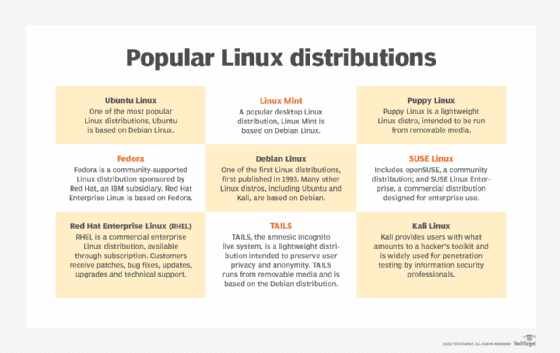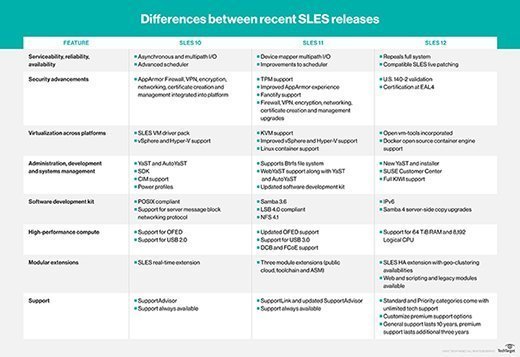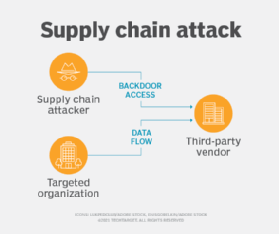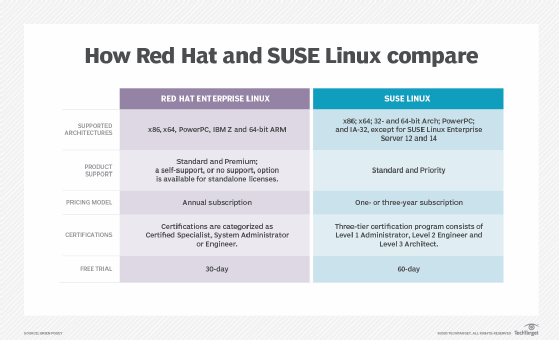SUSE Linux Enterprise Server (SLES)
What is SUSE Linux Enterprise Server (SLES)?
SUSE Linux Enterprise Server (SLES) is a Linux-based server operating system (OS) created and maintained by the German-based organization, SUSE. SLES is the SUSE Linux server operating system designed for mainframes and servers. It is mostly used with a support contract with SUSE.
SUSE Linux Enterprise Server was initially released in 2000 and has undergone multiple upgrades since. SUSE released its SUSE Linux Enterprise Server 10 in 2006, followed by SUSE Linux Enterprise Server 11 in 2009 and SUSE Linux Enterprise Server 12 in 2014. As of this writing, SLES 15 is the latest version available for use, which was released in 2018. There was no version 13 or 14.
SLES releases are often staggered by three to four years, with service packs released roughly every year to 18 months.
What SLES is used for?
SLES is an enterprise-focused Linux server distribution. Since SLES is an enterprise offering, SUSE company is responsible for updating and maintaining the releases. While it is an open source project and to an extent can be used for free, SLES is most used alongside a paid support subscription. The support subscription includes over the phone support and access to vetted repositories and knowledge bases. openSUSE is the fully open-source version.
While there are a lot of free and community-supported Linux server distributions, many organizations find value in using one with a paid support structure. If an outage could cost a million dollars an hour in lost revenue, the ability to immediately contact a support engineer can be incredibly valuable. Paid Linux server distributions also use a more stable and highly tested package base, which can help to reduce bugs and downtime versus a distribution that prioritizes using the latest releases.

Ease of administration and interoperability are key components of the latest SLES release. IT professionals can integrate SUSE Linux Enterprise Server into environments to increase architectural optimization without high amounts of downtime or interference. Containers and geo-clusters are also two areas of increased support and compatibility in the newest SLES release.
Users can now incorporate open source Docker container tools into their system. Geo-clusters give IT more flexibility with high-availability add-ons, by allowing administrators to set up replication clusters that span multiple data center locations.
SLES has partnerships with major hardware vendors such as Dell, Fujitsu and HPE. It is supported on Recent hardware advancements, such as Arm64 CPUs and with the latest NVIDIA GPUs.

SUSE Linux Enterprise Server advantages
Using a major enterprise Linux distribution offers many advantages compared to using a community-supported one.
- Access to up to 24-hour phone support and an extensive knowledge base.
- Tested and stable packages and releases. This can reduce the amount of downtime due to bugs in new software and reduce the likelihood of supply chain attacks introducing malicious software.
- Compatibility with major cloud vendors.
- Turnkey solutions for common use cases.
- Part of a large ecosystem of products provides a unified structure as opposed to cobbling together software from many different vendors.

SUSE Linux Enterprise Server in virtualized and cloud computing environments
Aside from supporting in-house workloads, SLES also is offered on a multitude of cloud service providers. Amazon Web Services, Google Compute Engine and Microsoft Azure all offer SLES-based cloud instances. IT teams that want to build or deploy custom OS images on these providers should consider SUSE Studio or third-party tools for higher levels of optimization.
SLES offers modern virtualization scenarios. It can be a guest OS on all major hypervisor platforms. It also supports modern containerization and virtualization technologies, such as KubeVirt.
Major SUSE Linux Enterprise Server competitors
In the Linux server distribution market, SUSE competes primarily with Red Hat and Canonical. Red Hat Enterprise Linux (RHEL) and Ubuntu are the two major competitors with SLES, as the distros share similar software components because of their open source capabilities. Features and hardware and software support are the main differences between each Linux distribution.
Each organization has a major footprint in the enterprise Linux and open source world offering a multitude of products and services.

SUSE Enterprise Linux vs. openSUSE
OpenSUSE is an open source community version of SUSE Linux. It is targeted to home and testing use. It uses the latest software releases and is not as stable as the enterprise offering.
SUSE has recently released the openSUSE Leap operating system. It is a freely available open-source Linux distribution that uses the same base and packages as the enterprise version. It can also be directly upgraded to SUSE Enterprise Linux with the purchase of a support package.
Comparing training, pricing and certifications when deciding between RedHat and SUSE. See how these Linux distributions stack up against one another.






